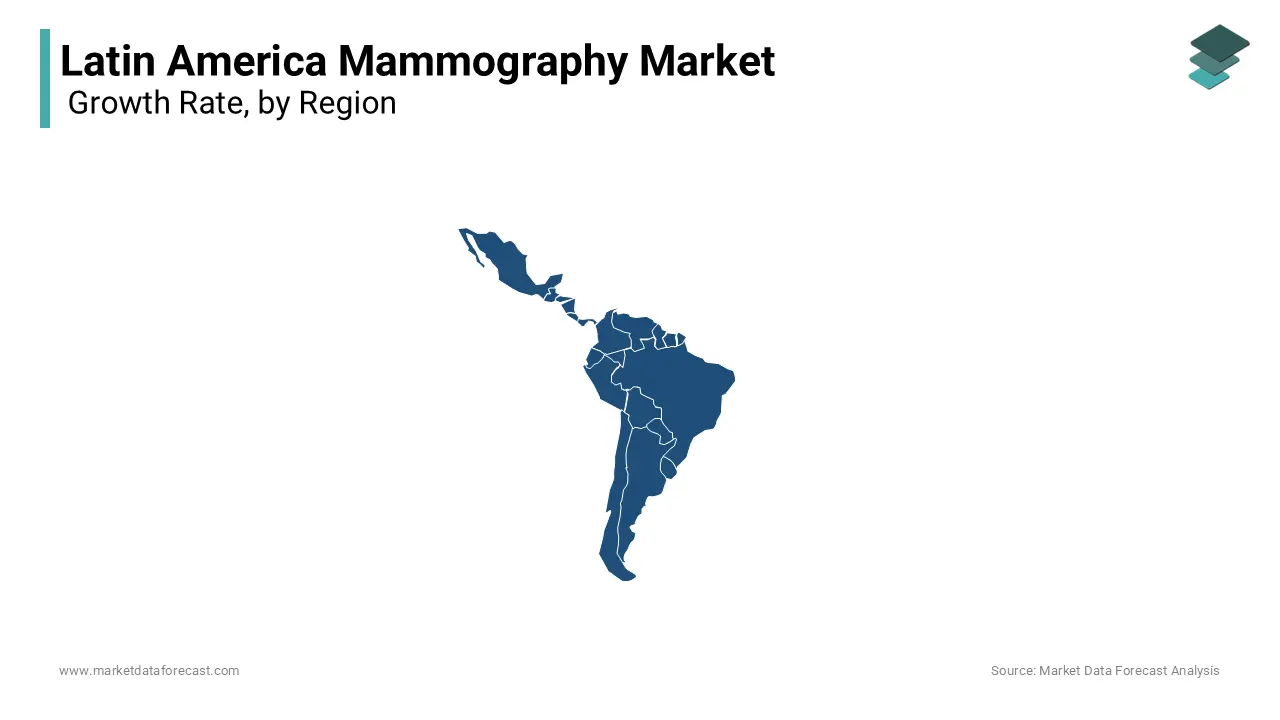Latin America Mammography Market Size, Share, Trends & Growth Forecast Report By Product, Technology, Application & Country (Brazil, Mexico, Argentina, Chile and Rest of Latin America), Industry Analysis (2025 to 2033
Latin America Mammography Market Size
The mammography market size in Latin America was valued at USD 156.76 million in 2024. The Latin American market is expected to grow from USD 167.58 million in 2025 to USD 285.79 million by 2033, growing at a CAGR of 6.9% from 2025 to 2033.

The mammography market in the Latin American region has witnessed significant advancements in technology, including the adoption of digital mammography systems and 3D tomosynthesis. These innovations have enhanced diagnostic accuracy and minimized false-positive rates. Countries such as Brazil, Mexico, and Argentina are at the forefront of adopting these advancements due to the modernization of healthcare infrastructure. However, challenges persist. Disparities in healthcare access, a shortage of skilled radiologists, and the high cost of advanced imaging systems hinder market growth in less-developed areas. According to the World Health Organization, breast cancer accounts for approximately 25% of all cancer diagnoses among women in Latin America, underscoring the pressing need for enhanced screening programs.
MARKET DRIVERS
Rising Incidence of Breast Cancer In Latin America
The increasing prevalence of breast cancer in Latin America is a major driver for the mammography market. According to the International Agency for Research on Cancer under the World Health Organization, more than 210,000 new cases of breast cancer were diagnosed in the region in 2020, which is approximately 15% of global cases. This alarming rise has fuelled the need for effective early detection tools, with mammography being the preferred modality for mass screenings. Governments across countries such as Brazil and Argentina have prioritized breast cancer control programs, increasing the adoption of mammography systems. Awareness initiatives by organizations such as PAHO are further encouraging women to undergo routine mammograms, which is expected to drive consistent demand in the region.
Technological Advancements in Mammography Systems
The adoption of advanced mammography technologies, such as digital breast tomosynthesis (DBT) and AI-enabled diagnostic tools, is transforming breast imaging in Latin America. The Pan American Health Organization highlights that digital mammography systems significantly enhance image quality, reducing false positives and unnecessary biopsies. Moreover, portable mammography units are increasingly used in remote areas, ensuring wider accessibility. Manufacturers such as Siemens Healthineers and GE Healthcare are introducing region-specific innovations, which have seen an uptick in installations, particularly in urban hospitals and cancer care centers. These technological advancements are making mammography more efficient and accessible, driving market growth.
Government-Sponsored Screening Programs
Government-led healthcare initiatives are pivotal in expanding mammography services across Latin America. For instance, Mexico’s Ministry of Health has implemented national screening programs offering subsidized mammograms for women aged 40 and above, aiming to increase early detection rates. Similarly, Brazil’s Unified Health System funds breast cancer screening campaigns, providing free mammograms to underserved populations. According to the Pan American Health Organization, these programs have facilitated a 30% increase in mammography uptake over the past decade. The growing investment in public health infrastructure continues to bolster access to mammography services, driving regional market growth.
Expanding Private Healthcare Infrastructure
The rapid expansion of private healthcare facilities in Latin America is another significant driver of the mammography market in this region. With urbanization and a growing middle-class population, demand for high-quality healthcare services has surged. Leading private hospital chains in Brazil and Mexico have reported a steady rise in the adoption of digital mammography and 3D imaging systems to meet patient expectations. The International Finance Corporation indicates that private healthcare investments in the region grew by 20% between 2015 and 2022, spurring the availability of advanced diagnostic services. This trend is expected to enhance access to mammography services, particularly in urban settings.
MARKET RESTRAINTS
Limited Access to Healthcare in Rural Areas
A significant challenge in the Latin American mammography market is the limited access to healthcare in rural and underserved regions. According to the Pan American Health Organization, over 30% of Latin America’s population lives in rural areas, where healthcare infrastructure is underdeveloped. These regions often lack mammography units, trained technicians, and radiologists, creating barriers to early breast cancer detection. For instance, in Bolivia and Honduras, mammography access is concentrated in urban centers, leaving rural women without timely screening options. This geographic disparity contributes to late-stage cancer diagnoses, leading to higher mortality rates. Bridging this gap requires mobile mammography units and telemedicine solutions, but high implementation costs and logistical challenges persist.
High Cost of Advanced Mammography Equipment
The high cost of digital mammography systems and 3D tomosynthesis devices is a significant barrier to market growth in Latin America. According to a World Bank report, many public healthcare facilities in low-income countries like Guatemala and Nicaragua lack the financial resources to procure and maintain advanced imaging technologies. Additionally, operational costs, including technician training and equipment maintenance, further strain healthcare budgets. This limits the availability of cutting-edge diagnostic tools in public hospitals, disproportionately affecting low-income populations. While regional governments are striving to subsidize equipment costs, fiscal constraints often delay widespread adoption.
Shortage of Skilled Radiologists
The shortage of skilled radiologists in Latin America is a critical challenge for the mammography market. Data from the World Health Organization reveals that the region has an average of only 10 radiologists per 100,000 people, compared to 26 per 100,000 in North America. This shortage is particularly acute in rural and less-developed areas, where healthcare professionals are scarce. Consequently, even when mammography equipment is available, the lack of trained personnel hinders timely and accurate diagnoses. This gap exacerbates patient backlogs and delays in treatment initiation, highlighting the need for improved training programs and telemedicine initiatives to support diagnostic workflows.
Cultural Stigma and Lack of Awareness
Cultural stigma and a lack of awareness about breast cancer prevention remain significant barriers to the adoption of mammography in Latin America. According to a study by the Pan American Health Organization, many women in the region avoid mammograms due to misconceptions about the procedure and fear of a cancer diagnosis. This is especially prevalent in conservative communities, where discussing women's health issues is often considered taboo. Additionally, educational campaigns are not reaching remote and underserved populations effectively. This lack of awareness contributes to low screening rates, with some countries reporting participation as low as 20%. Addressing this challenge requires culturally sensitive awareness programs and education initiatives to dispel myths and encourage regular screenings.
REGIONAL ANALYSIS

Brazil holds the largest share of the Latin America mammography market, driven by its robust healthcare infrastructure and extensive government-led breast cancer screening programs. The Ministry of Health of Brazil reports that nearly 60% of women aged 50–69 participate in biannual mammography screenings through its Unified Health System. Brazil is also a hub for technological advancements, with leading companies like Siemens and Hologic actively investing in the region. Additionally, its population size—over 214 million as per World Bank data—further solidifies its leadership. The government's "Pink October" campaign significantly raises awareness, enhancing early detection rates and cementing Brazil's importance in the regional mammography market.
Mexico is the fastest-growing market in Latin America, with a high growth rate attributed to its increasing investment in digital mammography and 3D breast tomosynthesis. The Mexican Social Security Institute highlights a 40% rise in mammogram screenings over the past decade, spurred by nationwide cancer awareness programs and improved healthcare access. Urbanization and a growing middle class are also driving demand for private healthcare services equipped with cutting-edge diagnostic technologies. Moreover, the government's National Cancer Control Program emphasizes early detection, further boosting market growth. Mexico’s strategic focus on enhancing both public and private sector healthcare infrastructure underscores its critical role in shaping the regional mammography landscape.
KEY MARKET PLAYERS
Companies playing a noteworthy role in the Latin American mammography market include Fujifilm, GE Healthcare, Hologic, Metaltronica, Philips Healthcare, Planmed, Siemens Healthcare, Sonocine, and Toshiba Medical Systems.
MARKET SEGMENTATION
This research report on the Latin American mammography market is segmented and sub-segmented into the following categories
By Product
- 3D mammograms
- Digital
- Analog system
- Film Screens
- Biopsy Systems
- Others
By Technology
- Analog
- Digital
- Breast tomosynthesis
By Application
- Screening
- Diagnostics
By Country
- Brazil
- Mexico
- Argentina
- Chile
- Rest of Latin America
Related Reports
Access the study in MULTIPLE FORMATS
Purchase options starting from $ 1600
Didn’t find what you’re looking for?
TALK TO OUR ANALYST TEAM
Need something within your budget?
NO WORRIES! WE GOT YOU COVERED!
Call us on: +1 888 702 9696 (U.S Toll Free)
Write to us: [email protected]
